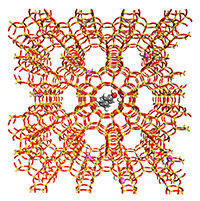Catalysis Research Featured in The Molecular Bond
(March 2015)

A zeolite is a porous aluminosilicate structure commonly used to catalyze reactions, including biomass-derived renewable fuel production. (Image created by Amity Andersen, EMSL scientist.) Enlarge/expand Image.
Cars that run on biomass-derived fuel and homes heated by wind energy that was generated weeks ago are ideas that need advances in catalysis. A class of catalysts known as zeolites has been used for decades, but many of their properties are not well understood. The latest Molecular Bond, published by DOE's EMSL, a national scientific user facility, focuses on zeolite research enabled by the facility. For example, Dr. Chuck Peden of Pacific Northwest National Laboratory's Institute for Integrated Catalysis discusses zeolite-based catalysts to reduce automotive emissions. Specifically, he talks about the copper-based zeolite Cu-SSZ-13, which removes nitrogen oxides in lean-burn (more air, less fuel) engines, eventually converting them to nitrogen. Using EMSL resources, Peden and his colleagues characterized the atomic intricacies of the catalyst, answering fundamental questions about its structure and behavior.
To learn more, read "Zeolites: The Inside Story."
